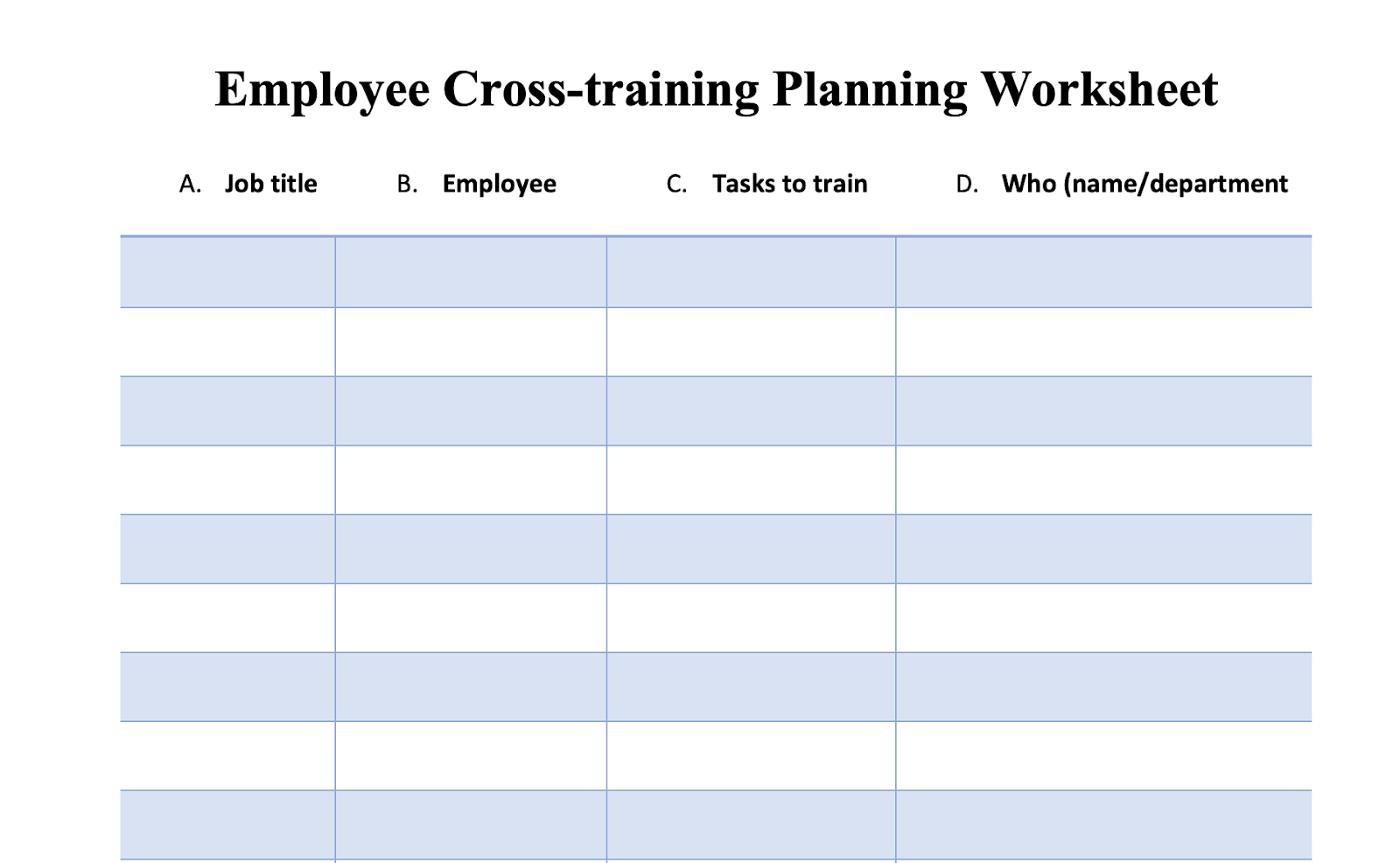Training and investing in your employees is an invaluable and necessary part of any business. Cross-training is the way to take this one step further, as it boosts productivity, creates multi-skilled employees, and builds cohesion amongst teams.
In this blog, you’ll learn what exactly employee cross-training is, the benefits, and how to implement it successfully.
What is a cross-training employee program?
Cross-training involves training employees in new skills so that they may fill additional roles if needed. Without it, an unexpected absence can lead to crisis training, outsourcing work, and serious deficits in productivity.
However, even ignoring this worst-case scenario, cross-training employees can have huge benefits for both employee and employer. For the employer, a cross-training program helps you identify skill gaps in your workforce and fill them, thus improving the depth and breadth of your team's talent. Additionally, it contributes to encouraging talent retention among employees.
For the employee, it provides professional development, increases awareness of the company as a whole, and produces a more collaborative workplace. On top of this, a successful cross-training employee program can vastly reduce the cost of hiring. Instead of spending time and money searching for someone outside your company to fill vacant positions, you can simply look through your team for the skills your company needs.
This is especially important for specialized roles, such as software development. For instance, if you're looking for software developers, you can consider cross-training your existing employees to fill the gap or hire Angular developers.
One way to streamline this process is by utilizing coworking space software, which can help identify the skills and availability of your employees in real time.

What are the benefits of cross-training in the workplace?
There are many benefits for you and your team, including:
Create workforce stability
As mentioned, a key employee leaving your team can leave a huge gap in your workforce. Say you’re a small company, and you have an expert HR Manager single-handedly running their department. If that person leaves, not only do you lose the value of their contributions, but you have no one to train their replacement either.
Cross-training employees means that team members can rotate, step into roles, and train other employees in your company's time of need.
Save money in the long-term
A more stable workforce, with employees that can switch between roles in emergencies, will help avoid excess expenditures on things like last-minute outsourcing.
On top of this, a successful cross-training employee program can vastly reduce the cost of hiring. Instead of spending time and money searching for someone outside your company to fill vacant positions, you can simply look through your team for the skills your company needs.
Better internal communication
As well as minimizing the productivity lost to unexpected absences, you are creating a workforce with a better understanding of the business around them. By teaching employees the roles of those around them, you will also improve communication between different sections and departments of your business.
Allow for more flexible scheduling
Having more staff-members who can fill the same role will make it easier for employees to fit their work around their life. It also makes it easier for employers to adapt scheduling - if someone needs time off, it’s easy to arrange cover.
Improve talent retention
More flexible scheduling combined with ongoing professional development is great for encouraging talent retention. The most common reasons people leave their roles are a lack of work-life balance and a desire for a flexible work schedule. By ensuring every role can be covered, you can provide this - and keep your team happy.

Another way cross-training employee programs can improve in talent retention is by allowing you to invest in “lower value” prospective employees. Anyone who’s posted a job listing will have seen applicants with little skills and experience who stress that they are willing to learn. Well, employee cross-training is a fantastic way of giving these applicants a foot up in their career, while training them to fill the exact skill gaps in your company.
How to execute a successful cross-training employee program?
There are many benefits to cross-training employee programs, but there are pitfalls too. At the end of the day, teaching employees new skills costs time and money, so if you're not getting a return on that investment, it could do more harm than good.
Here’s our best-practice tips for executing successful cross-training employee programs:
Invest time into research and development
Haste makes waste. Rushing into cross-training employee programs is a surefire way to make mistakes, and then lose time and money amending them.
When planning your program, it’s crucial to work out what methodology will suit your needs best. Broadly speaking, employee cross-training programs can fall into four categories:
- Shadowing - on-job job shadowing training led by a colleague or superior with the desired skill set
- Mentoring - leaders across the organization are paired with more junior team members to aid their development. This is less focused on specific job training, but assists career development and employee engagement.
- Self-led training - workers complete the necessary sessions and assessments at their own pace, predominantly through online courses and eLearning
- Instructor-led training - this usually takes place in a training room environment with a set schedule and lessons
Each has their own benefits and shortcomings depending on the role you're training for and the kind of worker, so it's best to experiment with different methods and adapt your programs accordingly. It’s also worth ensuring you provide a mix of in-person training and sessions via remote device access, to include all your staff.
Start small and stay selective
Starting small is good advice for any new venture in a business. Cross-training employee programs are no different. There will be a learning curve and you can better interpret successes and failures on a small controlled scale to begin with.
While the point of cross-training is to share skills between employees, it's still better to have individuals with specific focuses and expertise. Don’t try to train every employee on everything. Instead, consider how you can make the best use of your team and lean into their existing skill sets.
Clearly define roles and responsibilities
Set formal expectations for what you expect your programs to achieve, both for the company and for the employees.
Decide what extra responsibilities the trainee will take on and what they should gain from the experience. Make sure to clearly define and communicate how roles will change in any kind of job expansion, vertical or horizontal. This will help avoid employees feeling taken advantage of, and prevent unhealthy competition in the workplace.
Select your workers wisely
It’s worth putting thought into what employees will be best suited for cross-training. Some employees will be more interested in specializing than broadening their skillset, while others might already have a lot of work in their own role and be unable to take anything new on.
The best way to ensure you have the right person for the job is to get organized. We recommend making a table like the one below.

Column A lists the roles you wish to cross-train, Column B, those qualified to train the skill set, Column C, the exact task to be the employee must be trained in, Column D. the desirable candidates for the program.
Design a comprehensive program
Obviously, the details of your program will depend a lot on the role it is training for, but whatever that is, make sure you're teaching all aspects of the job.
As a rule, you want to separate cross-training for a role into three areas for development:
- Theoretical knowledge - and understanding the responsibilities of the role and the function it serves the business.
- Practical knowledge - the capability to perform the necessary tasks. This includes getting to grips with required technologies and software - i.e. the employee training for the position in your Canada branch should know how to use a VoIP phone in Canada. As part of practical knowledge, it's important to provide UI design tips to employees who will be working on user interfaces. This can include guidelines on color schemes, typography, layout, and accessibility. By ensuring that all employees involved in UI design are familiar with these best practices, you can create a more consistent and user-friendly experience for your customers.
- Employee integration - awareness of how their role fits within the context of the team.
During the planning stage, make sure each of these areas are addressed in your programs and set separate learning objectives for each.
Test out your training programs
Whatever your method, there will be a process of trial and error. The only way to get past this is to find your mistakes and learn from them.
To do this, it is imperative to document your program procedures fully, determine a standardized measure of their success, and keep track of your success. One way to do this is to run cross-training simulations. Give trainees the chance to show what they’ve learned in controlled setting under the supervision of more experienced employees
Another huge part of this is collecting feedback. To ensure your gathering as much valuable information as possible, survey beforehand to measure expectations, during the program to measure performance, and after to measure effectiveness.
Throughout this process, you should consider using tools such as business phone systems to facilitate easy communication and detailed feedback.
Finally, and perhaps most importantly, modify your programs based on these results - training shouldn’t be a stagnant thing, but rather, an ongoing process.
Keep programs up-to-date
As you train a new employee make sure they are being taught the current methods and practices for the role you would like them to move into - even if this means providing refreshers for those already in the role.
Make sure your tech stack is up to date too - there’s no good reason that any software walk-throughs should be done via presentations or text documents, when there are free screen recorders available, for instance. Utilizing up-to-date software and technology will streamline the work involved in creating the problems and make it easier for your workers to learn new skills.
Cross-training employee programs lead to successful businesses
Sometimes, the thing you’ve been looking for is right under your nose. For all you know, your company's future star is hiding in your org chart. So, invest in your team, and allow them to grow into what your business needs - and make sure you’re covered for any and all staff absences.
To continue developing your employees, consider starting a mentorship program that matches your leaders and experienced employees with those still learning the ropes. In doing so, you can not only accelerate their learning, but improve employee satisfaction and, in turn, retention rates.
Check out Together’s mentorship platform that makes it easy for companies to launch large scale mentoring programs with 250 employees or more. Connect with our team to get a personalized demo of our platform and start accelerating employee development at your company.








.svg)

.svg)
.svg)





.jpg)

.svg)









